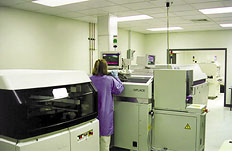

Center for Advanced Vehicle Electronics (CAVE)
Auburn University
A National Science Foundation Industry/University Cooperative Research Center since 1999
Research for cost-effective electronics manufacturing and packaging technologies for high-reliability electronics in a harsh environment
Center Mission and
Rationale
Electronics are a critical element in today's vehicles, accounting for 5%-8% of the vehicle cost. Microcontroller-based engine and transmission controllers enable automobile manufacturers to meet fuel efficiency and pollution levels mandated by government regulations while providing the customer with improved driving characteristics. Safety features such as anti-lock braking, airbags, and collision avoidance systems depend on electronics for their performance and reliability. Other customer preference features, such as active suspension, climate control, navigation, and entertainment, require electronics. The electronics content of vehicles continues to increase, and reliability of these increasingly complex systems is critical. The Center for Advanced Vehicle Electronics (CAVE) is dedicated to working with industry in developing and implementing new technologies for the packaging and manufacturing of electronics, with special emphasis on the cost, harsh environment, and reliability requirements of the vehicle industry.
Research Program
CAVE conducts a full spectrum of research ranging from manufacturing process development and material characterization to reliability testing and modeling. Areas in which the Center is currently conducting research include:
- Ball grid array packaging
- Lead-free manufacturing
- Flip-chip assembly and reliability
- High temperature electronics
- Connectors
- Assembly processes
- Relating laboratory environmental testing to field life.

|
Because the field of electronics manufacturing is multidisciplinary, collaboration between engineering disciplines and the physical sciences is essential. Faculty and scientific staff from two colleges and four departments contribute to the research efforts at Auburn University. The Center's researchers currently include more than eight faculty members and professional and scientific staff, as well as ten graduate and six undergraduate students. Within Auburn University, Transportation and Information Technology have been identified as priority program areas. The research activities within CAVE provide a bridge between these two important priority programs.
In addition to participating in the Industry/University Cooperative Research Centers Program, CAVE is active in other major research programs, including:
- "Wafer-Scale Applied Reworkable Fluxing Underfill for Direct Chip Attach," funded by the National Institute of Standards and Technology Advanced Technology Program. This program will develop the materials and processes for the next generation of flip-chip assembly technology.
- "Printed Wiring Board Finishes for Lead-free Soldering," funded by the Printed Wiring Board Manufacturing Technology Center. The solder wetting and reliability characteristics of lead-free printed wiring board finishes with lead-free solders are being investigated.
- "Aluminum Nitride Packages for High Power, High-Temperature Electronics," funded by NASA. Conventional silicon-based electronics have an operating temperature maximum of 150°-175°C, with 125°C more typical. Silicon carbide-based electronics allow device operation to over 500°C. New assembly and packaging technology is required for this temperature range.
Facilities
Four university laboratories support the Center research program:
- Laboratory for Electronics Assembly and Packaging (LEAP)
- Experimental and Computational Mechanics Laboratory
- Thermal Sciences Laboratory
- Surface Science Laboratory
These laboratories provide complete facilities for the design, manufacture, environmental testing, characterization, and failure analysis of electronic assemblies. The laboratories also support materials and process equipment characterization, as well as manufacturing process development. The Laboratory for Electronics Assembly and Packaging has an automated SMT/flip-chip assembly line, as well as automated wire bonding equipment for test vehicle assembly and prototype fabrication.
Assembly Equipment: MPM AP stencil printer, Siemens Siplace 80 F5 pick and place, Heller Series 1800 reflow oven, Cam/Alot 3700 dispense system, AirVac DRS24 rework station, Yield Engineering YES R3 plasma etch system, Palomar Products Model 2460-V automatic thermosonic wire bonder, Orthodyne 360B automatic large diameter wire bonder, Karl Suss 150 precision flip-chip bonder/aligner.
Characterization and Environmental Test Equipment: Multicore MUST II solderability tester, Tencor surface profilometer, Brookfield viscometer, Dage PC2400 with load cartridges for wire pull, ball shear and die shear, Compix PC2100 thermal imaging system with magnifying lens, Buehler cutting saw and polishing system for cross-sections, Nikon measuring microscope (to 1000x) with digital imaging, Cambridge Stereoscan 90 scanning electron microscope with EDX, Sonix acoustic microscope, Phoenix micro-focus x-ray, Wisdom Technologies micro tensile-torsion thermo-mechanical test system, Blue-M burn-in ovens, Blue-M thermal cycle (air) chambers, Blue-M thermal shock (liquid) chamber, Blue-M humidity chamber, Express Test HAST-6000 chamber, Keithley Instruments 7002 switch boxes and 2001 multimeters, and Pentium-based personal computers with GPIB and LabView software.
Materials Analysis Equipment: Auger electron spectroscopy (AES,2), X-ray photoelectron spectroscopy (XPS,2), Rutherford backscattering spectroscopy (RBS), scanning electron microscopy (SEM,3), SEM/energy-dispersive x-ray spectroscopy (EDX,2), Nomarski and stereo light microscopy; ion scattering spectroscopy (ISS), scanning kinetic spectroscopy (SKS), mass spectroscopy (QMS,2), temperature programmed desorption (TPD); and a full range of capabilities for failure analysis.
Unique Solder Materials Facilities: wetting balance; video recording and heating capabilities on SEM/EDX to enable in-situ, real-time observation of solder wetting characteristics; variable-pressure, bell-jar wetting system allows study of process gas variations on solder wetting; high-pressure, UHV-compatible wetting chamber attached to surface analysis system allows for surface analysis during solder wetting and spreading; torsion oscillating viscosity system enables measurement of solder viscosity; oscillating sessile drop method measures solder surface tension.
Membership
CAVE currently has 11 members representing material, component, equipment, electronics assembly companies and federal agencies. The vertically integrated membership represents the infrastructure and technologies necessary for the design and assembly of vehicle electronics.
Center Headquarters
Center for Advanced Vehicle Electronics
Auburn University
162 Broun Hall/ECE Dept.
Auburn, AL 36849-5201
Tel (334) 844-1880*Fax (334) 844-1898
Homepage: www.eng.auburn.edu/department/ee/cave/
Center Director: Dr. R. Wayne Johnson
johnson@eng.auburn.edu
Center Evaluator: Dr. Ralph Zee
(334) 844-2301 * rzee@eng.auburn.edu
NSF 01-168b